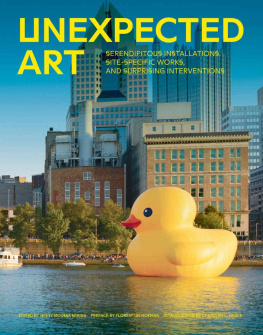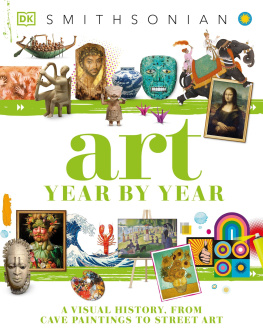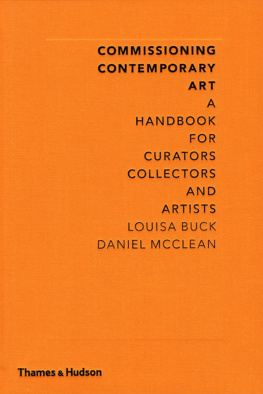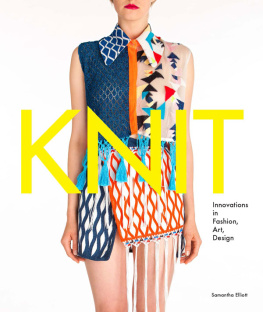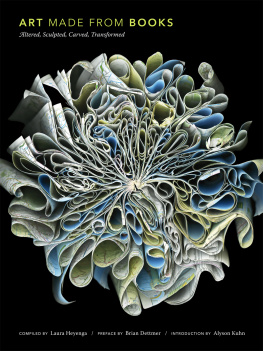
Copyright 2014 by Chronicle Books.
Preface text 2014 by Florentijn Hofman.
All rights reserved. No part of this book may be reproduced
in any form without written permission from the publisher.
constitutes a continuation of the copyright page.
Library of Congress Cataloging-in-Publication Data available.
ISBN: 978-1-4521-3548-9 (hc)
ISBN: 978-1-4521-4407-8 (epub2, mobi)
Design by Matthew Rezac (matthewrezac.org)
This book has been set in Programme (optimo.ch)
Chronicle Books LLC
680 Second Street
San Francisco, CA 94107
www.chroniclebooks.com
CONTENTS
PREFACE BY FLORENTIJN HOFMAN
You dont have to buy a ticket to a public space. Its yours. Its not like going to a theater or a museum, where you are choosing to be exposed to a type of art. It is my job as an artist, if I am allowed the use of a public space, to connect the audience to my work. You have to involve the people. The audience is not only the spectatorsit is part of the art.
Recently, I visited my hometown. Its a small place, the kind of place where everyone knows one another. The neighbors were happy to see me; theyve been keeping up with my career as I have become more well-known. One neighbor came up to me and said, Do you remember, Florentijn, when you used to build scenes out of soapboxes and come around asking us to see what you had made? As a child of six or seven, I would create little worlds, adventurescapes, fantasy lands, out of soapboxes and take them around the neighborhood asking, Have you seen what I made?
I always had the sense that if I was going to make art, it had to be big, and it had to touch many people. From my days as an art student, when I started a small business with two friends painting murals each summer, public artwork is what I fell into naturally. After I graduated, I continued my work with public spaceI had a feel for it, a love for it.
I love the connection with people. And I love the unique challenges posed by working in a public space. There are clearly logistical considerations in work of this scope: dealing with the paperwork and the local governments, making a work asshole-proof, as we call it in Holland; that is, protecting it from vandals. The challenges of public installationsthe approvals, the safety standardspush you to be more creative. There are problems that you have to solve, issues to overcome. As a result, it becomes a collaborative process. Part of the strength of the work comes from this collaboration with the many hands that touch it.
When beginning a project, I start with a site visit. You have to take into account all of the ingredientsthe history of the place, the demographics, who lives there, the buildingseverything that comes together to make the place what it is. A public space can become so familiar that a person doesnt see it anymore. People pass through a space that theyve been through dozens, even hundreds, of times before, and it has become completely invisible, utterly strange, to them. When I insert a new object into that space, it provides a bright new perspective to the viewers, so that all of a sudden, they experience their surroundings once more.
Changing the volume of the space is one way to make the familiar fresh and new. The materials I use are also key to providing the unexpectedI have used flip-flops, tiles, plastic bags, thatch. If I try to astonish myself first and foremost, I can feel confident about bringing the awe factor to an installation.
Slow Slugs, in Angers, France, took many hands to complete. I worked with dozens of volunteers who tied forty thousand plastic bags to the frames forming the slugs, which crawled up the stairs to the church. Seeing this location in Angers, a stairway to a churchto God, to religion, to deathas well the way to a commercial district behind the church, brought to mind a race to the finish. The slow race of slugs up the church stairs combined with the suffocating effects of plastic bags and commercialism all came together in this public work. As with many public pieces, it was up for only a short timedaysbut if I have succeeded in changing the space, providing the audience with a new perspective, then the impact has been made. And the work will live on in publications and on the Internet.
A dozen years ago, I bought a world map. I fashioned stickers in the shape of a rubber duck, and I stuck them all over the map in the hopes that one day, I would bring my Rubber Duck projecta giant version of the childs bath toyto these places. Now, its happening. The Rubber Duck has been to more than twenty locations in eleven countries, and the momentum is growing. Its an installation in which the audience reaction, the joy, the togetherness, is intrinsic to the experience. We all want to be amazed and astonished. The strong visual reference to a familiar objectan enormous rubber duckdraws the audience in. The scale of the Rubber Duck turns the harbor, bay, river into a giant bathtub and makes us all feel small. The audience becomes part of the installation, its reaction integral to the piece. You could be a CEO or a butcher, but we are all the same before this work. It interacts with all layers of society. It makes the world smaller. In my work, I play with scale. The effect of my work is to change your perception of reality.
Art doesnt always have to be difficult; you dont have to sweat to understand it. It can be a work that is all about relating, where we are all free to watch and investigate and discover. My sculptures dont change reality. They reveal what is already there and make you part of it.
INTRODUCTION SITE-SPECIFIC INSTALLATION: SOME HISTORIC CONTEXT BY CHRISTIAN L. FROCK
Over the past century, art has evolved from conventional studio methods, such as painting or sculpture, to include wide-ranging approaches to art making, including conceptual ideas, time-based media, performances and happenings, and many other experimental forms. Many of these shifts have resulted from expansive ideas about the location for art beyond the studio or the gallery. This awareness of how art can reflect on or challenge the conditions of our milieu has also led to the development of site-specific installation. As a style of working, site-specific installation can be generated from any discipline. Painting can be site-specific, as can sculpture, performance, or digital art. Regardless of medium, site-specificity is primarily distinguished by an intrinsic relationship to location. Site-specificity indicates that the work simply cannot exist in the same form in another space; even if the artwork could be relocated, its significance would be lost. This inseparability may stem from material constraints or from location as a basis for understanding, among other reasons, but it is also anchored in perception and, in this way, offers the possibility of uniquely intimate and unmediated transmission of the artists intentions. This essay offers a selection of recent histories from which to consider the development of ideas around site-specific art, as well as the shifting terrain surrounding various private and public sites as critical context.
In the late 1920s, the German painter Kurt Schwitters began work on a series of installations that occupied rooms in his family home. The first work, known as The Merzbau (19231936), transformed several rooms with installations that were part collage, part sculpture, and part abstract diorama. Schwitters fled Germany for Norway in 1937. In the rare images that remain, after an Allied bombing raid destroyed The Merzbau in 1943, we see a room commanded by jutting angles and a fantastical, immersive stage set of three-dimensional shapes. This installation was part of a larger body of work Schwitters referred to simply as the
Next page
